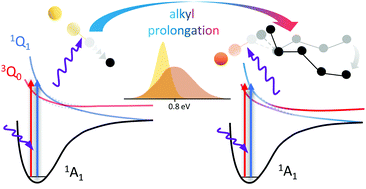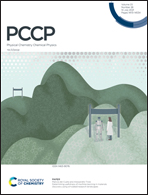Energy partitioning and spin–orbit effects in the photodissociation of higher chloroalkanes†
Abstract
We investigate the photodissociation dynamics of the C–Cl bond in chloroalkanes CH3Cl, n-C3H7Cl, i-C3H7Cl, n-C5H11Cl, combining velocity map imaging (VMI) experiment and direct ab initio dynamical simulations. The Cl fragment kinetic energy distributions (KEDs) from the VMI experiment exhibit a single peak with maximum close to 0.8 eV, irrespective of the alkyl chain length and C–Cl bond position. In contrary to CH3Cl, where less than 10% of the available energy is deposited into the internal excitation of the CH3 fragment, for all higher chloroalkanes around 40% to 60% of the available energy goes into the alkyl fragment excitation. We apply the classical hard spheres and spectator model to explain the energy partitioning, and compare the classical approach with direct ab initio dynamics simulations. The alkyl chain appears to be a soft, energy absorbing unit. We further investigate the role of the spin–orbit effects on the excitation and dynamics. Combining our experimental data with theory allows us to derive the probability of the direct absorption into the triplet electronic state as well as the probabilities for intersystem crossing. The results indicate an increasing direct absorption into the triplet state with increasing alkyl chain length.



 Please wait while we load your content...
Please wait while we load your content...